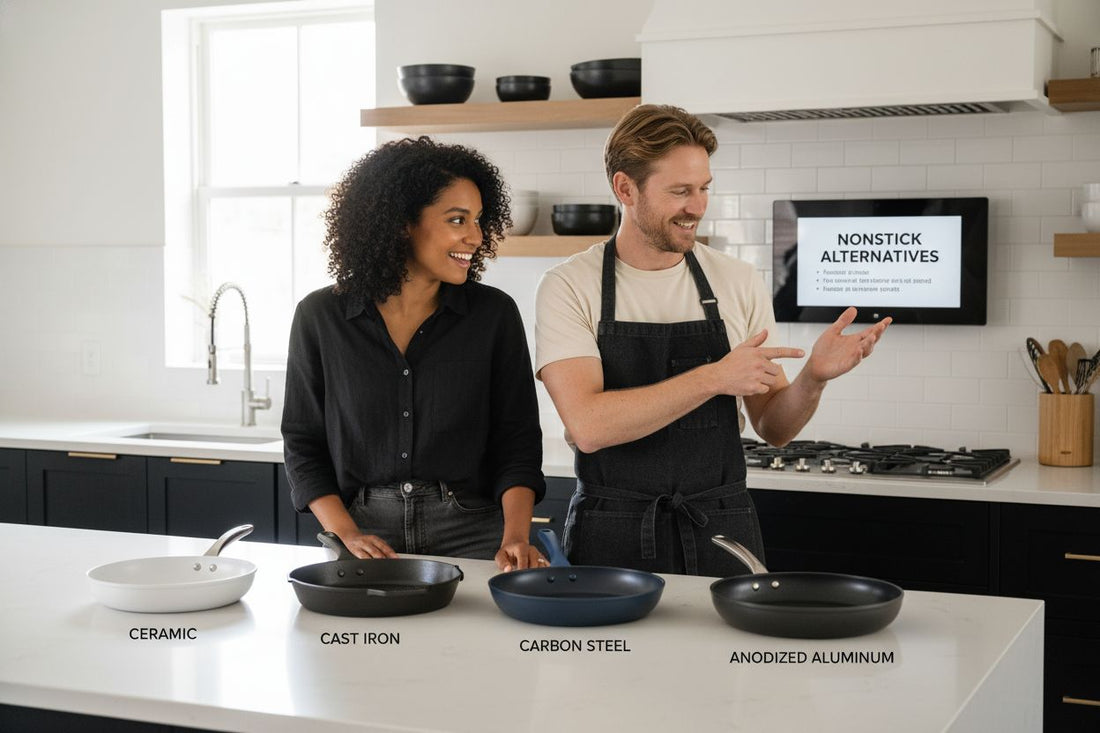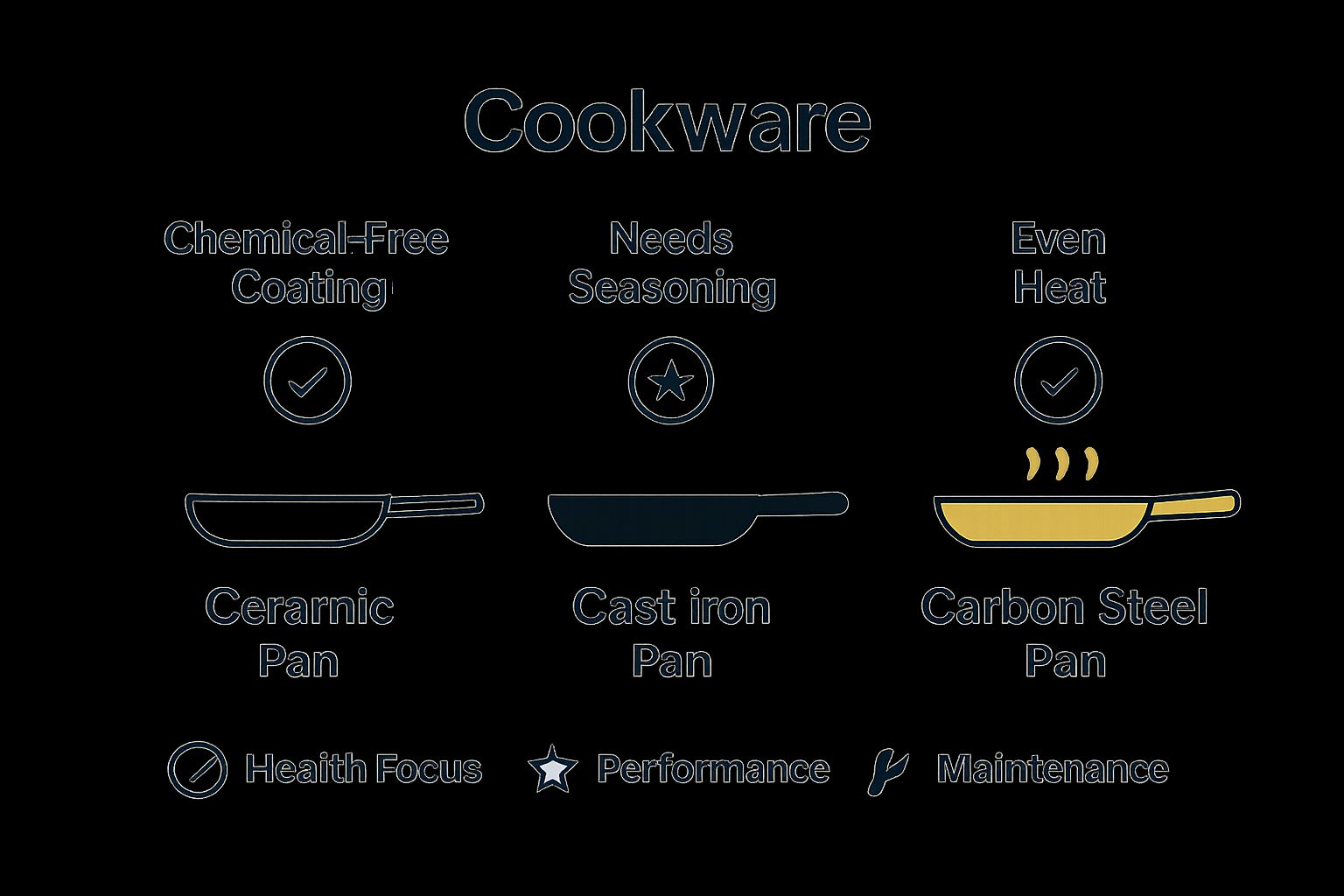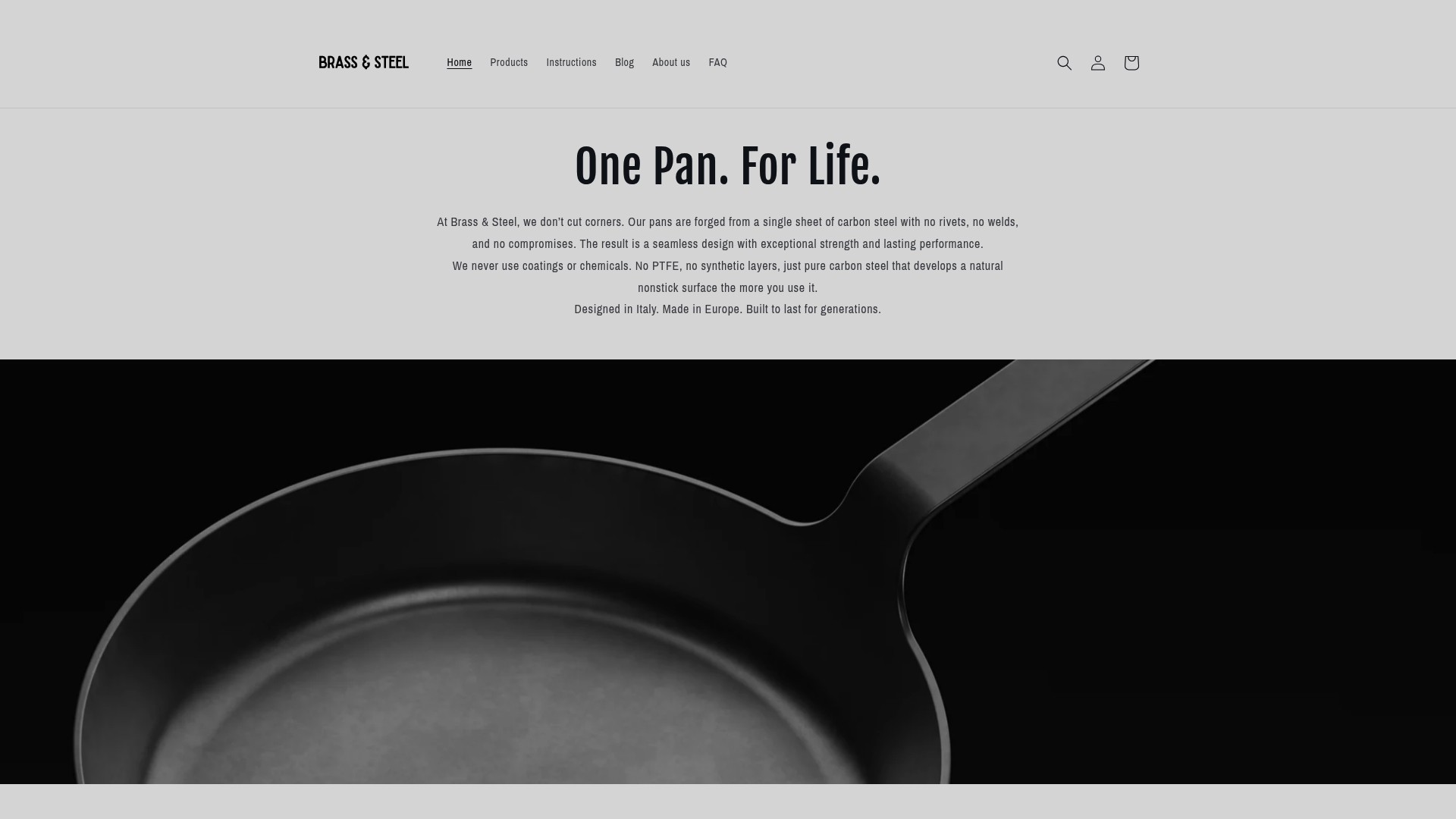
Nonstick Alternatives Explained: Understanding Safe Options
Share
Nonstick cookware has long been prized for making meals effortless to prepare and clean up. Yet most people never realise that traditional nonstick pans often contain synthetic chemicals like PTFE and PFOA, which can release toxic fumes at high temperatures. What truly turns expectation on its head is that safe nonstick alternatives like ceramic, cast iron, and anodised aluminium can actually outperform old-school coatings, offering both peace of mind and top-tier cooking results.
Table of Contents
- Defining Nonstick Alternatives: What Are They?
- The Importance Of Choosing The Right Nonstick Surface
- How Nonstick Alternatives Work: Materials And Mechanisms
- Key Concepts: Safety And Performance Of Nonstick Options
- Real-World Applications: Which Nonstick Alternatives To Choose?
Quick Summary
| Takeaway | Explanation |
|---|---|
| Choose safer nonstick alternatives | Select cookware made from materials like ceramic or cast iron to avoid health risks associated with traditional nonstick coatings. |
| Match cookware to cooking techniques | Different nonstick surfaces excel in various cooking methods; choose based on your culinary needs for optimal results. |
| Prioritise long-term durability | Assess the durability and heat stability of materials to ensure they withstand repeated use without degrading. |
| Evaluate health and safety standards | Select cookware with minimal chemical reactivity to safeguard your health while cooking. |
| Understand surface mechanisms | Familiarise yourself with how nonstick alternatives prevent sticking through material properties for informed cooking choices. |
Defining Nonstick Alternatives: What Are They?
Nonstick alternatives represent cooking surfaces engineered to provide safe, efficient cooking experiences without relying on traditional chemical-based nonstick coatings. These innovative solutions prioritise both culinary performance and health considerations, offering home cooks and professional chefs multiple options beyond conventional nonstick technology.
The Core Problem with Traditional Nonstick Surfaces
Traditional nonstick cookware typically uses polytetrafluoroethylene (PTFE) and perfluorooctanoic acid (PFOA), synthetic chemicals linked to potential health risks. Harvard Health researchers have highlighted concerns about these compounds, which can release toxic substances when overheated.
Safe Nonstick Alternative Categories
Nonstick alternatives broadly fall into several key categories, each offering unique benefits:
- Ceramic Coated Cookware: Provides smooth cooking surface with minimal chemical intervention
- Cast Iron Cookware: Naturally develops nonstick properties through seasoning
- Carbon Steel Pans: Creates natural nonstick surface through careful maintenance
- Anodized Aluminium: Hard surface treatment reducing sticking without synthetic coatings
These alternatives represent a thoughtful approach to cooking technology, balancing performance with safety.
 Learn more about carbon steel cookware choices to understand how professional chefs select their preferred cooking surfaces.
Learn more about carbon steel cookware choices to understand how professional chefs select their preferred cooking surfaces.
By understanding these nonstick alternatives, home cooks can make informed decisions that protect their health while maintaining excellent cooking results.
The following table compares the key characteristics of four main nonstick alternative cookware options discussed in the article, helping readers easily identify which surface may be most suitable for their needs.
| Nonstick Alternative | Nonstick Mechanism | Durability | Maintenance Required | Safety Profile |
|---|---|---|---|---|
| Ceramic Coated Cookware | Ultra-smooth ceramic surface | Moderate | Gentle cleaning | No synthetic chemicals |
| Cast Iron | Natural seasoning (oil layer) | Very high | Regular seasoning | Naturally non-toxic |
| Carbon Steel | Natural seasoning (oil layer) | High | Careful maintenance | Naturally non-toxic |
| Anodised Aluminium | Hard treated surface | High | Basic cleaning | No PTFE/PFOA |
The Importance of Choosing the Right Nonstick Surface
Selecting an appropriate nonstick cooking surface extends far beyond aesthetic preferences or kitchen convenience. This decision directly impacts food quality, cooking performance, long-term health, and overall culinary experience. Professional chefs and home cooks alike recognise that cookware is not merely a tool but a critical component of gastronomic success.
Health and Safety Considerations
The materials used in cookware interact with food at molecular levels, potentially transferring substances during cooking. Environmental Working Group researchers have extensively documented potential risks associated with traditional nonstick coatings, highlighting the significance of selecting surfaces that minimise chemical interactions.
Performance and Cooking Efficiency
Different nonstick surfaces offer unique advantages in cooking performance:
- Heat Distribution: Some materials conduct heat more evenly, preventing hot spots
- Durability: Certain surfaces withstand higher temperatures without degrading
- Maintenance Requirements: Each surface demands specific care techniques
- Versatility: Some cookware performs better across multiple cooking methods
Explore professional chef cookware insights to understand how expert cooks evaluate cooking surfaces.
Ultimately, choosing the right nonstick surface involves balancing health considerations, cooking performance, personal cooking style, and long-term investment in kitchen equipment. Informed decisions transform cooking from a mundane task into a sophisticated culinary experience.

How Nonstick Alternatives Work: Materials and Mechanisms
Nonstick alternatives function through sophisticated material engineering, creating cooking surfaces that prevent food adhesion without relying on synthetic chemical coatings. These innovative approaches leverage natural properties and precise surface treatments to deliver exceptional cooking performance.
Surface Interaction and Molecular Design
The fundamental mechanism behind nonstick alternatives involves manipulating surface characteristics to reduce friction and prevent ingredient adherence. National Institutes of Health researchers have demonstrated that different materials achieve this through unique molecular structures and surface treatments.
Primary Nonstick Mechanism Types
Nonstick alternatives employ several distinct mechanisms to prevent food sticking:
- Molecular Smoothness: Ceramic and anodized surfaces create ultra-smooth molecular landscapes
- Natural Oil Polymerisation: Cast iron and carbon steel develop protective seasoning layers
- Surface Hardness: Treated metals create microscopic barriers preventing ingredient adhesion
- Thermal Conductivity: Some materials distribute heat so evenly that ingredients cannot stick
Discover more about cookware material science and understand the engineering behind modern cooking surfaces.
Understanding these mechanisms empowers cooks to select cookware that matches their specific culinary techniques, transforming cooking from a potential challenge into a precise, enjoyable experience.
Key Concepts: Safety and Performance of Nonstick Options
Choosing nonstick alternatives requires understanding the complex interplay between material safety, cooking performance, and long-term durability. Modern cookware solutions must balance multiple critical factors to provide an exceptional culinary experience without compromising health standards.
Evaluating Material Safety Standards
Environmental Protection Agency researchers have extensively documented the risks associated with traditional chemical coatings, driving a significant shift towards materials that demonstrate minimal chemical reactivity and superior safety profiles. This evolving landscape demands careful material selection based on scientific evidence and comprehensive testing protocols.
Performance and Durability Considerations
Nonstick alternatives are assessed through several critical performance metrics:
- Thermal Stability: Ability to withstand high cooking temperatures without degradation
- Chemical Inertness: Minimal interaction with food ingredients
- Mechanical Resilience: Resistance to scratching and surface damage
- Heat Distribution: Uniform temperature transmission across cooking surface
Explore our comprehensive non-toxic cookware guide to understand the nuanced world of safe cooking surfaces.
Ultimately, selecting the right nonstick alternative involves a holistic approach that considers individual cooking styles, health priorities, and long-term kitchen performance expectations.
Real-World Applications: Which Nonstick Alternatives to Choose?
Navigating the landscape of nonstick alternatives requires understanding how different materials perform across varied cooking scenarios. Professional chefs and home cooks alike must match their cookware selection to specific culinary techniques, ingredient types, and personal cooking preferences.
Matching Cookware to Cooking Styles
Consumer Reports experts highlight that selecting the right nonstick alternative depends on understanding each material’s unique characteristics. Some surfaces excel in high-heat searing, while others shine in delicate sauce preparation.
Practical Recommendations by Cooking Technique
Different nonstick alternatives demonstrate optimal performance in specific cooking scenarios:
- High-Heat Searing: Carbon steel and cast iron provide exceptional heat retention
- Delicate Egg Preparations: Ceramic surfaces offer smooth, gentle cooking environments
- Acidic Food Cooking: Stainless steel provides superior chemical resistance
- Quick Weeknight Meals: Anodized aluminium offers rapid, even heating
Explore professional cookware selection strategies to understand nuanced material performance.
Ultimately, the perfect nonstick alternative transcends technical specifications, becoming an extension of the cook’s culinary vision and technique.
This table outlines how different nonstick alternative materials perform across various cooking techniques, making it simple to match cookware to your everyday culinary requirements.
| Cooking Technique | Ideal Nonstick Alternative | Reason for Recommendation |
|---|---|---|
| High-Heat Searing | Carbon Steel, Cast Iron | Superior heat retention and even searing |
| Delicate Egg Dishes | Ceramic Coated Cookware | Smooth gentle surface allows easy release |
| Acidic Ingredient Cooking | Stainless Steel | Excellent chemical resistance to acidic foods |
| Fast, Even Heating | Anodised Aluminium | Rapid and uniform heat distribution |
| Versatile Use | Cast Iron, Carbon Steel | Adaptable to a range of methods and oven-safe |
Discover Safe Nonstick Alternatives with Brass & Steel
If you are seeking a truly safe and high-performance nonstick alternative, you are not alone. The article uncovered the dangers of PTFE and PFOA, as well as the frustrations of searching for nonstick cookware that does not compromise your health or cooking results. Choosing a natural nonstick pan that offers reliability, safety, and longevity is a priority for any cook who values both culinary excellence and well-being. Our Carbon Steel Collection directly addresses these pain points by providing natural nonstick performance through seasoning, unmatched durability, and freedom from chemical coatings.

Take action today and explore the advantages of carbon steel cookware that grows better with each use, holding up to both professional demands and everyday family cooking. Browse our full range of heirloom-quality pans or visit our main website for in-depth guides on making a confident, healthy switch to a professional carbon steel pan. Elevate your kitchen and protect your household now by choosing a safe, science-backed alternative.
Frequently Asked Questions
What are the main types of nonstick alternatives available?
Nonstick alternatives include ceramic coated cookware, cast iron, carbon steel, and anodized aluminium. To choose the best option, consider your cooking style and the types of dishes you prepare.
How do ceramic coated surfaces compare to traditional nonstick surfaces?
Ceramic coated surfaces are made without the synthetic chemicals used in traditional nonstick cookware, making them a safer choice. Opt for ceramic cookware for a smooth cooking experience that still offers decent food release and easier cleaning.
Can cast iron cookware truly be a nonstick alternative?
Yes, cast iron develops its own nonstick properties through seasoning over time. Start by properly seasoning your cast iron skillet and maintain it by regularly applying a thin layer of cooking oil after each use to enhance its nonstick capabilities.
What should I consider when choosing nonstick alternatives?
When selecting nonstick alternatives, evaluate factors such as material safety, cooking performance, and maintenance requirements. Determine your cooking needs and match them with the strengths of each material to enhance your culinary experience.
How do I maintain nonstick surfaces to ensure longevity?
To maintain nonstick surfaces, use gentle cleaning methods and avoid harsh abrasives. Regularly clean them with mild dish soap and soft sponges, and store them carefully to prevent scratches, ensuring they last longer in your kitchen.
Recommended
- Non-Toxic Cookware Choices: Carbon Steel vs Ceramic Pans – Brass & Steel
- How to Decide Between Carbon Steel and Nonstick Pans for Everyday Cook – Brass & Steel
- Understanding Carbon Steel vs Nonstick Comparison for Chefs – Brass & Steel
- Understanding Carbon Steel Pan Safety Guide for Chefs – Brass & Steel
- Decoding Plastic: How to Choose Food-Safe Containers - Probe IT